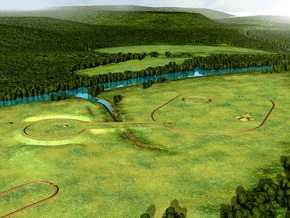CINCINNATI,
LITTLE MIAMI
TURNER EARTHWORKS
Head out Round Bottom Road to the east from Newtown, to where a railroad overpass appears on the right. Beyond the rail line, contemplate the overgrown gravel quarries that were once the spectacular Turner Earthworks. From here came some of the Hopewell culture’s most spectacular artistry, including clay figurines, the mica serpent, and an effigy of a strange horned creature.
Here, two enclosures, one high, one low, were connected by a graded way. A long form trailed to the southwest. There were several mounds; but most unusual was a symmetrical cluster laced together by rings of stone. Doctor Charles Metz, of Madisonville, and Frederick Ward Putnam of Harvard University, investigated at Turner in the 1880s, and found some of the Hopewell Culture’s most spectacular artistry. Plowing of the earthworks had begun as early as 1825; and eventually it was all destroyed by a graveling operation.
Two mounds in this cluster contained remarkable secrets: In one, fires were lit in complex, clay-lined pits and chambers. Intense heat and smoke could rise through narrow flues. In an adjoining mound, a magnificent mica snake lay atop ritual deposits. Mica often cloaked such deposits; but here, as a serpent, it may have carried special meanings still known in the Woodland Indian tradition. Beneath the mica serpent were painted pottery statues, showing how the people dressed and arranged their hair.

Gravel pits near Round Bottom and Mt. Carmel Roads destroyed the Turner Earthworks.


